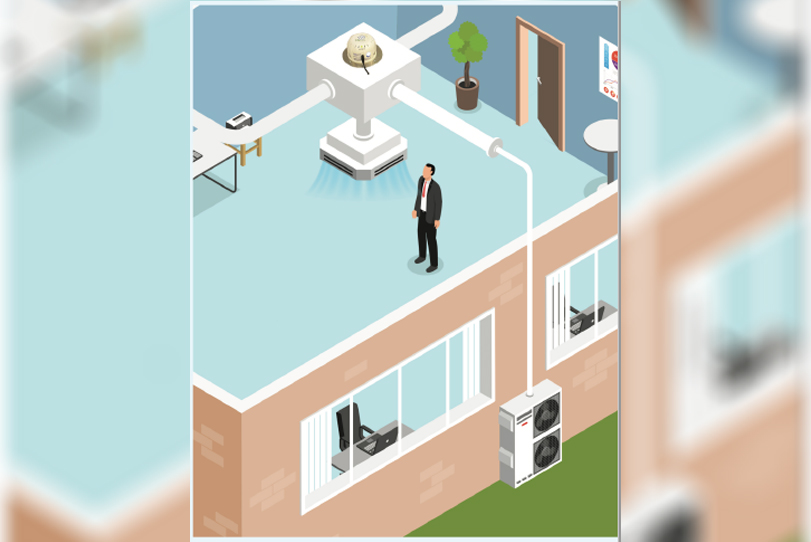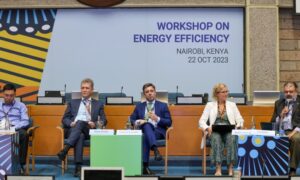HVAC system is undergoing drastic changes with evolving times, necessitating the need for innovative HVAC solutions for green buildings.
Swanky glass and steel buildings are an integral part of the urban landscape of any industrialised country. But, have you wondered how such a large working space is powered for the required heating and cooling? Generally, it is through a centralised HVAC (Heating, Ventilation and air conditioning) system. With the advancement in technology and greater awareness about the environment, the HVAC system has undergone drastic changes with evolving times. More than ever, there is a need for innovative HVAC solutions for green buildings. HVAC system accounts for nearly 40-50 percent of the total energy used in commercial buildings. The green concept and technique used in the design and development of green buildings can address pressing issues like energy efficiency, water efficiency, reduction in fossil fuel use, consumer waste handling and conservation of natural resources.
A group of like-minded knowledgeable humans has come together to build awareness about green building technology through stringent standards. Some of the prominent ones are the World Green building Council, the US Green building Council, Canada green building council, etc. The Indian Green Building Council (IGBC) rating system allocates rating on Sustainable architecture and design, Site selection and planning, water conservation, Energy-efficiency, Building materials and resources, indoor environment quality, innovation and development.
How India is positioned on Global Green Building Ratings?
- India has the 3rd highest green building growth rate in the world.
- India has over 7.55 billion sq. ft. of green built-up space and continues to expand in this segment.
- Government push to have 200 million sq. meters of green-certified buildings by 2022.
- There is a high demand for green building because of rising consumer awareness.

HVAC Solutions for Green Building-
- Demand-Controlled Ventilation: Early detection of the pollutants in the building air stream can significantly improve indoor air quality and the energy efficiency of the HVAC systems. This can be made possible with the use of advanced sensors and control technology. Under demand-controlled ventilation, less fresh air is supplied to save energy when the no. of occupants is less. The fresh air is supplied in proportion to the indoor CO2 concentration. The use of CO2 sensors based on actual occupancy rate can reduce unnecessary over ventilation. The demand-controlled ventilation can result in energy-efficient operations especially for warm and humid climates and buildings with low internal gains (low occupant densities).
- Indirect-Direct Evaporative Cooling, 2- Stage: In the first stage, hot outside air is passed through a heat exchanger that is cooled through evaporation on the outside. In the initial incoming phase, the incoming air stream doesn’t pick up any extra moisture. The 2nd stage involves passing the same air stream through a water-soaked pad where the additional cooling takes place and the air picks up additional humidity.
- Desiccant-based Cooling: A Desiccant is a hygroscopic substance that is used to induce or sustain a state of dryness in its vicinity. Generally, sensible and latent cooling loads are addressed with the same piece of equipment. The latent cooling loads can be controlled through the use of desiccants. The Desiccant-based system is designed to provide cooling without refrigeration. In such systems, a desiccant removes moisture from the air that releases heat and increases the air temperature. Afterward, the dry air is cooled using evaporative cooling or the cooling coils of a conventional air conditioner. The adsorbed moisture is removed from the desiccant using the thermal energy supplied by electricity, natural gas, waste heat, or the sun. Some of the common commercially available desiccants include activated alumina, silica gel, natural and synthetic zeolites, lithium chloride, titanium silicate, and synthetic polymers. In Desiccant-based cooling systems, various components require electricity for operation but they use less than a conventional HVAC system.
- Adopt Active Air Purification Technique like REME & PHI: A traditional HVAC system has multiple media filters including the highly efficient HEPA and activated carbon filters. large pressure drops results in consumption of extra electricity. An innovative solution is the use of Active Air Purification Technique like REME & PHI cell inducts system. The desired air purification can be achieved at a much lower level of electricity consumption resulting in cost-efficient and energy efficient operations.
- Underflow Air Supply System: In this kind of system, all the air from the outside is delivered to the building volume in a close proximity to the occupants. Some of the most relevant applications could be large high spaces like airport terminals and convention centres. The system uses the concept of displacement ventilation where cool and ventilated air is delivered low down.
Another underflow air supply system uses a plenum space that accommodates cabling system delivering conditioned air without the need for air ducting. This approach is much more flexible and has the capability to provide better thermal comfort, indoor air quality and lifecycle cost savings.
In the underflow air supply system, the warm air from the gadgets and the computer rises high as per nature and the cold air from under the floor float within the room keeping it fresh and maintained. Since the indoor atmosphere is fresher than before, the energy consumption will be under control and the cost of air conditioning will be lowered too.
- HVAC system accounts for dominant percentage of total energy used in commercial buildings. Zeco Aircon has developed some of its technology for green buildings. One of them is the Smart AHU. Zeco smart AHU can save up to 25 percent cost in energy and maintenance costs by transforming your current system into an energy-efficient and cost-efficient solution.
Features it offers are:
- Demand control ventilation with integrated IAQ monitors and parameters.
- High-efficiency fans & motors with low noise.
- Customised solution based on the end-user requirement.
- Easily accessible remotely through Desktop, Laptop Tablet Smart Phone so no needs to put long cable, etc.
- Can be integrated with a fire alarm system, BMS, etc.
- Handheld control panel with display.
Source:
- https://edgebuildings.com/wpcontent/ uploads/2018/05/India- Green-Building-Market-Intelligence. pdf
- https://realty.economictimes. indiatimes.com/news/industry/ almost-14-lakh-houses-in-india-arenow- green/66828963#:~:text=Almost percent2014 percent20lakh percent20houses percent20in percent20India percent20have percent20chosen percent20to percent20go,properties percent20present percent20in percent20the percent20country.
- https://www.researchgate. net/profile/Sam_C_M_Hui/ publication/228606734_ HVAC_design_and_operation_ for_green_buildings/ links/0a85e538ffab30a365000000/ HVAC-design-and-operation-forgreen- buildings.pdf
Cookie Consent
We use cookies to personalize your experience. By continuing to visit this website you agree to our Terms & Conditions, Privacy Policy and Cookie Policy.















